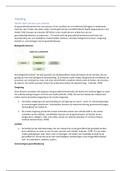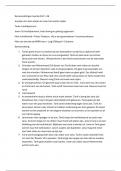Biochemische Technieken
Deel 1: Biochemische werkwijzen
Inhoudsopgave
1 Inleiding .................................................................................................................................... 5
2 Waterdiverse stoffen – Buffers.................................................................................................... 6
2.1 Eigenschappen van water............................................................................................................ 6
2.1.1 Inwendige structuur van water ............................................................................................... 6
2.1.2 Hydrofobe interacties ............................................................................................................ 6
2.2 Invloed van diverse stoffen .......................................................................................................... 6
2.2.1 Interactie met water .............................................................................................................. 6
2.2.1.1 Organische solventen ..................................................................................................... 7
2.2.1.2 Zouten............................................................................................................................ 7
2.2.1.3 Ureum en guanidine-HCl ................................................................................................. 7
2.2.1.4 Chaotrope stoffen ........................................................................................................... 7
2.2.2 Directe interactie met de biomolecule.................................................................................... 8
2.2.2.1 Ionogene zepen .............................................................................................................. 8
2.2.2.2 Niet-ionogene zepen ....................................................................................................... 9
2.2.2.3 Zwitterionen ................................................................................................................... 9
2.2.2.4 Reductantia voor disulfidebindingen .............................................................................. 10
2.2.2.5 SH-reagentia ................................................................................................................ 10
3 Homogenisatie van cellen en weefsels ...................................................................................... 10
3.1 Uitgangsmateriaal..................................................................................................................... 10
3.1.1 Soort .................................................................................................................................. 10
3.1.2 Plaats ................................................................................................................................. 10
3.1.3 Tijdstip ................................................................................................................................ 11
3.2 Activiteit van hydrolytische enzymen .......................................................................................... 11
3.3 Homogenisatiemethoden .......................................................................................................... 12
3.3.1 Algemene richtlijnen............................................................................................................ 12
3.3.2 Methodes ........................................................................................................................... 12
3.3.2.1 Potter-Elvehjem buis ..................................................................................................... 12
3.3.2.2 Blender ........................................................................................................................ 12
3.3.2.3 Mortier ......................................................................................................................... 12
3.3.2.4 Schudden met glaskorrels ............................................................................................. 12
3.3.2.5 Toepassing van druk ..................................................................................................... 13
3.3.2.6 Osmotische shock ........................................................................................................ 13
3.3.2.7 Chemisch: SDS + EDTA ................................................................................................. 13
3.3.2.8 Ultrasonoor geluid ........................................................................................................ 13
, 3.3.2.9 Enzymatisch ................................................................................................................. 13
4 Zuivering van nucleïnezuren ...................................................................................................... 14
4.1 Algemene strategie ................................................................................................................... 14
4.1.1 Uitgangsmateriaal ............................................................................................................... 14
4.1.2 Extractiemethoden .............................................................................................................. 14
4.2 Beschadiging van nucleïnezuren ................................................................................................ 15
4.2.1 Chemische schade ............................................................................................................. 15
4.2.2 Biologische schade ............................................................................................................. 15
4.2.2.1 DNA-nucleasen of DNasen ............................................................................................ 15
4.2.2.2 RNA-nucleasen of RNasen ............................................................................................ 15
4.2.3 Stralingsschade .................................................................................................................. 16
4.2.4 Mechanische schade .......................................................................................................... 16
4.3 Concentratiebepaling ............................................................................................................... 16
4.3.1 UV-absorptie....................................................................................................................... 16
4.3.1.1 Absorptiecentrum ......................................................................................................... 16
4.3.1.2 Extinctiecoëfficiënt bij 260 nm ....................................................................................... 17
4.3.2 Fluorescentie ...................................................................................................................... 17
4.3.2.1 Ethidiumbromide .......................................................................................................... 17
4.3.2.2 Submarine elektroforese ............................................................................................... 17
4.3.2.3 GelRed ......................................................................................................................... 18
4.3.2.4 SYBRgreen .................................................................................................................... 18
4.2.3.5 Qubit fluorometer ......................................................................................................... 18
4.3.3 Capillaire elektroforese ....................................................................................................... 18
4.3.4 Kleurreacties ...................................................................................................................... 18
4.3.5 Radioactieve detectie .......................................................................................................... 19
4.4 Denaturatie en renaturatie ........................................................................................................ 19
4.4.1 Denaturatie......................................................................................................................... 19
4.4.2 Renaturatie ......................................................................................................................... 19
4.4.3 Smelttemperatuur ............................................................................................................... 19
4.5 Isolatie en zuivering................................................................................................................... 21
4.5.1 Manuele methodes ............................................................................................................. 21
4.5.1.1 Isolatie van hoogmoleculair DNA ................................................................................... 21
4.5.1.2 Plasmide-isolatie .......................................................................................................... 22
4.5.1.3 Isolatie mRNA ............................................................................................................... 22
4.5.2 Kits ..................................................................................................................................... 23
4.6 Zuiverheid ................................................................................................................................ 24
4.7 Identificatie .............................................................................................................................. 24
4.8 Restrictie-enzymen ................................................................................................................... 24
4.8.1 Endonuclease of restrictie-enzymen .................................................................................... 24
4.8.2 Restrictie-enzymklassen ..................................................................................................... 24
4.8.3 Steractiviteit ....................................................................................................................... 25
4.8.4 Isochizomeren .................................................................................................................... 25
4.8.5 Naamgeving ........................................................................................................................ 25
Louise Peeters Samenvatting 2
, 4.8.6 Activiteit ............................................................................................................................. 26
4.8.7 Reactieomstandigheden...................................................................................................... 26
4.8.8 Gevoeligheid voor dam en dcm methylatie ........................................................................... 27
4.9 Oefeningen ............................................................................................................................... 28
5 Zuivering van eiwitten ............................................................................................................... 31
5.1 Algemene strategie ................................................................................................................... 31
5.2 Efficiëntie van de zuiveringsstap ................................................................................................ 32
5.3 Concentratiebepaling (!!)........................................................................................................... 32
5.3.1 Eenheid van concentratie .................................................................................................... 32
5.3.2 Methoden ........................................................................................................................... 33
5.3.2.1 UV-absorptie ................................................................................................................ 33
5.3.2.2 Biureetreactie ............................................................................................................... 33
5.3.2.3 Bradford methode ......................................................................................................... 33
5.3.2.4 Bepaling van het drooggewicht ...................................................................................... 34
5.4 Fractionering ............................................................................................................................ 34
5.4.1 Oplosbaarheid .................................................................................................................... 34
5.4.1.1 Isoëlektrische precipitatie ............................................................................................. 35
5.4.1.2 Zoutprecipitatie ............................................................................................................ 35
5.4.2 Ammoniumsulfaat-fractionatie ............................................................................................ 35
5.4.2.2 Centrifugeren ............................................................................................................... 36
5.4.2.3 Op punt stellen van de fractionering .............................................................................. 36
5.4.3 Oplosmiddelfractionering .................................................................................................... 37
5.4.4 Selectieve denaturatie ......................................................................................................... 37
5.5 Verwijdering van zouten ............................................................................................................ 38
5.5.1 Gelpermeatiechromatografie ............................................................................................... 38
5.5.2 Filtratie ............................................................................................................................... 38
5.5.2.1 Structuur ...................................................................................................................... 38
5.5.2.2 Karakterisering van een membraan ................................................................................ 38
5.5.2.3 Transport door een membraan ...................................................................................... 39
5.5.3 Dialyse ............................................................................................................................... 39
5.6 Bewaring .................................................................................................................................. 39
5.7 Maken van een eiwitoplossing ................................................................................................... 40
5.7.1 Oplossen van het eiwit ........................................................................................................ 40
5.8 Detectie van denaturatie ........................................................................................................... 40
6 Eiwitkarakterisatie .................................................................................................................... 41
6.1 Primaire structuur = AZ-sequentie.............................................................................................. 41
6.1.1 Edman degradatie ............................................................................................................... 41
6.1.2 Vertaling DNA...................................................................................................................... 42
6.1.3 Peptide massa ‘fingerprint’ analyse...................................................................................... 43
6.2 Conformatie ............................................................................................................................. 43
6.2.1 X-stralen kristallografie........................................................................................................ 43
Louise Peeters Samenvatting 3
, 6.2.2 Elektronenmicroscopie ....................................................................................................... 43
6.2.3 NMR spectroscopie ............................................................................................................. 43
7 Proteomics ............................................................................................................................... 44
7.1 Wat is proteomics ..................................................................................................................... 44
7.2 Waarom proteomics ................................................................................................................. 44
7.3 Traditionele proteomics ............................................................................................................ 44
7.3.1 Tweedimensionale gelelektroforese ..................................................................................... 44
7.3.2 Beeldanalyse ...................................................................................................................... 44
7.3.3 Massaspectrometrie ........................................................................................................... 45
7.3.3.1 Vormen van ionen ......................................................................................................... 45
7.3.3.2 Analyse van ionen in TOF massaspectrometer ............................................................... 45
7.3.4 Bioinformatica .................................................................................................................... 45
7.4 Praktisch voorbeeld .................................................................................................................. 45
Louise Peeters Samenvatting 4
,1 Inleiding
> Dit schema is algemeen geldig of men eiwit isoleert uit zijn natuurlijk milieu of aangemaakt heeft
via recombinant-DNA-technologie
> De gekozen zuiveringsmethoden zijn afhankelijk van de grootte en aard van de moleculen
Louise Peeters Samenvatting 5
, 2 Waterdiverse stoffen – Buffers
2.1 Eigenschappen van water
> Water is een molecule met een sterk dipoolmoment en vormt makkelijk waterstofbruggen, dit
resulteert in volgende eigenschappen:
» Grote diëlectriciteitsconstante (permeativiteit)
» Goed oplosmiddel voor polaire stoffen
» Hoge verdampingswarmte
» Hoge oppervlaktespanning
» Bijzondere inwendige structuur!!
» Optreden van hydrofobe interacties!!
2.1.1 Inwendige structuur van water
> Groot verschil in ENW tussen O en H à sterk dipoolmoment
> Vrije elektronenparen op O vormen samen met H de hoekpunten van een tetraëder
> In water vormen zich clusters van watermoleculen met een sterke inwendige structuratie:
entropie (S) neemt af
2.1.2 Hydrofobe interacties
> Vaststellingen:
» Apolaire ketens gaan associëren bij oplossing in H2O
» Eiwitten + nucleïnezuren komen in bepaalde conformatie voor in water
» Eiwit/peptide neemt na synthese zeer geordende biologisch actieve conformatie aan
> Verklaring:
» Dit is thermodynamisch!
» Men streeft naar een minimale inwendige energie (G) en zo groot mogelijk entropie (S)
» Als keten niet oprolt: sterke structuratie rond hydrofobe zijketens, dit is entropisch niet
gunstig
» Als keten wel oprolt: wordt compacter, de bewegingsvrijheid stijgt en dit is entropisch
gunstig
» Waterstofbrugvorming van H2O met aminozuurzijketens op uitwendige oppervlak van
eiwit versterken conformatie
> De stabiliteit vd conformatie is door het entropie-effect (dat hydrofobe groepen naar elkaar drijft)
en de VDW-krachten tussen apolaire groepen of de extra H-bruggen tussen watermoleculen
> Is een zeer labiel evenwicht, biomoleculen kan makkelijk denatureren
2.2 Invloed van diverse stoffen
> In water neigt biomolecule zich te ontrollen en streeft H2O naar een maximumaantal
waterstofbruggen
> Een stof kan de conformatie van een biomolecule beïnvloeden door:
» Interactie met water: wijziging structuur/conformatie van biomolecule
» Directe interactie met biomolecule
2.2.1 Interactie met water
> Organische stoffen hebben een verzwakkende en zouten een versterkende werking op:
» Onderlinge aantrekking tussen watermoleculen
» Oppervlaktespanning
Louise Peeters Samenvatting 6










